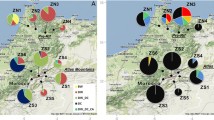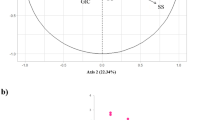Abstract
Wheat (Triticum spp.) landrace populations in Ethiopia are mostly species mixtures. However, no quantitative data is available with regard to their species components. We studied here 32 wheat landrace populations originating from two regions (Bale and Wello). A total of 2559 individual plants, 45–110 plants representing each population, were classified into their species components. Five tetraploid (2n = 4x = 28) and one hexaploid (2n = 6x = 42) wheat species were found in mixtures of varying proportions. These included the tetraploids Triticum durum Desf., Triticum turgidum L., Triticum aethiopicum Jakubz., Triticum polonicum L., Triticum dicoccon Schrank and the hexaploid Triticum aestivum L. Also found, however in a rare frequency, in two populations from Wollo was T. durum Desf. convar. durocompactoides Flaksb. (Triticum pyramidale Percival), which is a very dense spiked durum. Discriminant analysis using seven qualitative traits revealed 91.5% correct classification of the wheat species, beak awn and awn length with the most significant importance. Single species were found in eight of the populations; six were for T. durum and two for T. aethiopicum. Two to three species-combinations were the most frequent; a maximum of four species was recorded in one population. The highest diversity index (H′) observed was 0.44. T. durum was the most predominant species. The hexaploid T. aestivum was found in nine of the Wollo populations and, in one population, its frequency reached up to 35.5%. On altitudinal basis, no clear trend of clinal variation was observed both from the frequency distributions and H′ estimates. The results confirmed that Ethiopian wheats, despite the morphological overlaps, could be classified into their species components with high degree of certainty. For the future, therefore, genetic diversity estimations should be dissolved into their species components for more expeditious utilization and conservation of this important genetic resource.
Similar content being viewed by others
References
E. Bekele (1984) ArticleTitleAnalysis of regional patterns of phenotypic diversity in the Ethiopian tetraploid and hexaploid wheats Hereditas 100 131–154
G. Belay Y. Furuta (2001) ArticleTitleZymogram patterns of a-amylase isozymes in Ethiopian tetraploid wheat landraces: insight into their evolutionary history and evidence for gene flow Genet. Resour. Crop Evol. 48 507–512 Occurrence Handle10.1023/A:1012055915502
G. Belay A. Merker (1999) ArticleTitleC-band polymorphism and chromosomal rearrangements in tetraploid wheat (Triticum turgidum L.) landraces from Ethiopia Wheat Info. Serv. 88 6–14
G. Belay A. Merker (1997) ArticleTitleCytogenetic analysis of a spontaneous 5B/6B translocation in tetraploid wheat landraces from Ethiopia and implications for breeding Plant Breed. 117 537–542
G. Belay T. Tesemma D. Mitiku A. Badebo E. Bechere (1997) ArticleTitlePotential sources of stripe rust (Puccinia striiformis) resistance in durum wheat Rachis 16 70–74
G. Belay T. Tesemma E. Bechere D. Mitiku (1995) ArticleTitleNatural and human selection for purple-grain tetraploid wheats in the Ethiopian highlands Genet. Resour. Crop Evol. 42 387–391
G. Belay A. Merker T. Tesemma (1994) ArticleTitleCytogenetic studies in Ethiopian landraces of tetraploid wheat (Triticum turgidum L.). I. Spike morphology vs. ploidy level and karyomorphology Hereditas 121 45–62 Occurrence Handle10.1111/j.1601-5223.1994.00045.x
A. Demissie G. Habtemariam (1991) Wheat genetic resources in Ethiopia H. Gebremariam (Eds) et al. Wheat Research in Ethiopia: A Historical Perspective IAR/CIMMYT Addis Ababa 33–46
Dorofeev V.F., Filatenko A.A., Migušova E.F., Udaˇhin R.A. and Jakubziner M.M. 1979. Flora of Cultivated Plants. I. Wheat. Leningrad, 346 p. (Russian, English summary).
M. Feldman F.G.H. Lupton T.E. Miller (1995) Wheats: Triticum spp. (Gramineae–Triticinae) J. Smartt N.W. Simmonds (Eds) Evolution of Crop Plants EditionNumber2 Longman Scientific and Technical Singapore 184–192
InstitutionalAuthorNameIPGRI (1994) Descriptors of wheat (Triticum spp.) International Plant Genetic Resources Institute Rome, Italy
T. Kawahara S. Taketa (2000) ArticleTitleFixation of translocation 2A/4B infers the monophyletic origin of Ethiopian tetraploid wheat Theor. Appl. Genet. 101 705–710 Occurrence Handle10.1007/s001220051534
J. Mac Key (1966) ArticleTitleSpecies relationship in Triticum Hereditas 2(Suppl.) 237–276
Mesele T. 1989. Cytogenetic activities at PGRC/Ethiopia. PGRC/E-ILCA Germplasm Newsletter No. 20 April 1989. 24 pp.
MINITAB,1998. MINITAB Users Guide, released 12.22. MINITAB Inc.
J. Percival (1921) The Wheat Plant Duckworth London
E. Porceddu P. Perrino (1973) ArticleTitleWheat in Ethiopia: preliminary report of a collecting mission Plant Genet. Resour. Newslett. 30 33–36
E. Porceddu P. Perrino G. Olita (1973) Preliminary information on an Ethiopian wheat germplasm collection mission G.T. Scarascia-Mugnozza (Eds) Proceedings Symposium Genetics and Breeding of Durum Wheat University of Bari Italy 181–200
P. Sylvia (1995) Poaceae (Gramineae) H. Inga E. Sue (Eds) Flora of Ethiopia Addis Ababa Ethiopia/Uppsala, Sweden 68–63
A.T. Szabó K. Hammer (1996) Notes on the taxonomy of farro: Triticum monococcum, T. dicoccon and T. spelta S. Padulosi (Eds) et al. Hulled Wheats Proceedings of the Inter national Symposium Castelvecchio Pascoli Italy 2–40
T. Tesemma G. Belay (1991) Aspects of tetraploid wheats with emphasis on durum wheat genetics and breeding H. Gebremariam M. Hulluka D.G. Tanner (Eds) Wheat Research in Ethiopia: A Historical Perspective IAR/CIMMYT Addis Ababa 47–71
T. Tesemma B. Getachew M. Worede (1991) ArticleTitleMorphological diversity in wheat landrace populations from central highlands of Ethiopia Hereditas 114 172–176
N.I. Vavilov (1951) ArticleTitleThe origin, variation, immunity and breeding of cultivated plants Chronica Bot. 13 1–351
N.I. Vavilov (1997) Five Continents IPGRI Rome
A.E. Watkins S. Ellerton (1940) ArticleTitleVariation and genetics of the awn in Triticum J. Genet. 40 243–270
A.C. Zeven J.M.J. Wet Particlede (1982) Dictionary of Cultivated Plants and Their Regions of Diversity: Excluding Most Ornamentals, Forest Trees and Lower Plants Center for Agricultural Publishing and Documentation Wageningen
Author information
Authors and Affiliations
Corresponding author
Rights and permissions
About this article
Cite this article
Eticha, F., Belay, G. & Bekele, E. Species Diversity in Wheat Landrace Populations from two Regions of Ethiopia. Genet Resour Crop Evol 53, 387–393 (2006). https://doi.org/10.1007/s10722-004-6095-z
Received:
Accepted:
Issue Date:
DOI: https://doi.org/10.1007/s10722-004-6095-z




